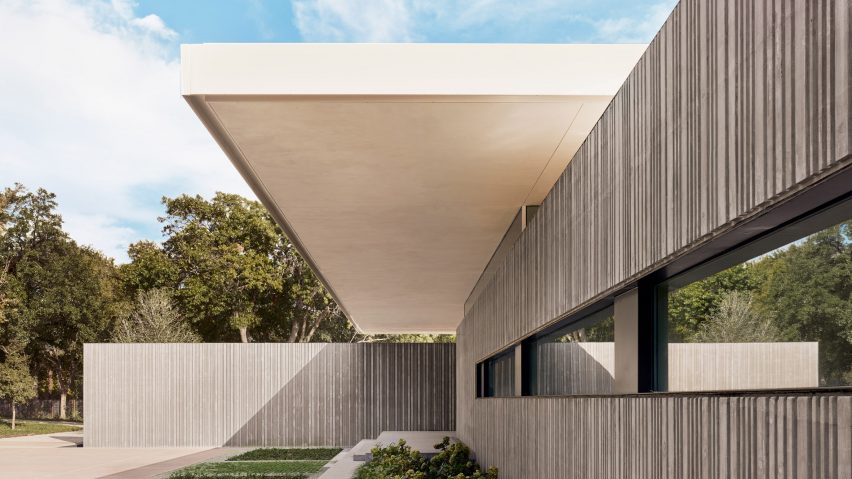American studio Specht Architects has designed this Dallas residence with long corrugated concrete volumes to reference brutalist architecture.
The Preston Hollow home is influenced by the texture and shape of modern Dallas, Texas houses built in the 1950s and 1960s. Its plan is spread across three long cast concrete volumes that comprise 8,826 square feet (820 square metres).
Specht Architects oriented each of the orthogonal structures to wrap around courtyards, grassy patches and stone covered patios.
Large windows and steel columns are paired with corrugated concrete walls that were constructed using custom-fabricated formwork. The textured material gives the residence its brutalist appearance while the thin window frames and metal pillars intend to soften its heaviness.
"This technique, a staple of brutalist architecture from the 1960s and 70s creates a play of shadows and pattern that changes throughout the day," said studio founder Scott Specht.
"Unlike the brutalist work from that era, however, the heavy walls here are countered by delicate steel columns, thin window frames, and the hovering cantilevered edges of the roof," he continued.
"The concrete is a grounding element that provides a contrast to the overall lightness of the spaces."
Concrete steps and gravel pathways that surround the volume are shaded by a flat overhang that spans across a portion of the house. A rectangular opening is cut into the roof structure above a courtyard situated at the centre of the house.
The cutout, an impluvium modelled after traditional Roman houses, is designed to let rainwater and sunlight reach the array of plants in the central garden space.
A stream that lights up at night snakes around the edge of the residence and cuts into the partially open courtyard space. Its water flows into the rectangular swimming pool that runs alongside one of the concrete volumes.
Inside, the studio has painted the walls a bright white and covered the floors in the main living spaces with light coloured hardwood. Some of the precast concrete walls are left exposed inside.
Corrugated concrete clads a fireplace in one of the light-filled sitting rooms, while dark wood planks are used to cover an additional hearth in the master bedroom.
In the kitchen, stainless steel appliances are paired with white counters and wood cabinets. The space opens to the formal dining area, which is furnished with retro red chairs and playful light fixtures that reference the design of the mid-century era.
Specht Architects was founded by architect Scott Specht, and has offices in New York City and Austin.
It has completed a number of projects in the US including a cedar beach house on stilts in New Jersey and a concrete residence that overlooks New Mexico's mountain landscape.
Photography is by Casey Dunn.
Project Credits:
Architect: Specht Architects
Landscape architect: Hocker Design Group
Interior design: Magni Kalman Design
Contractor: Sebastian Construction

